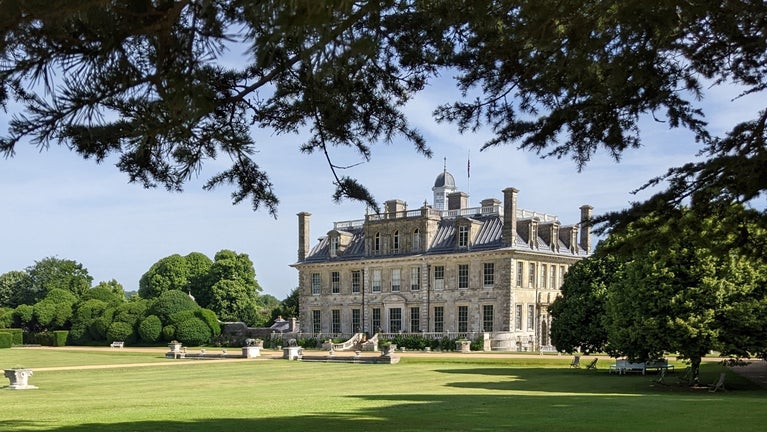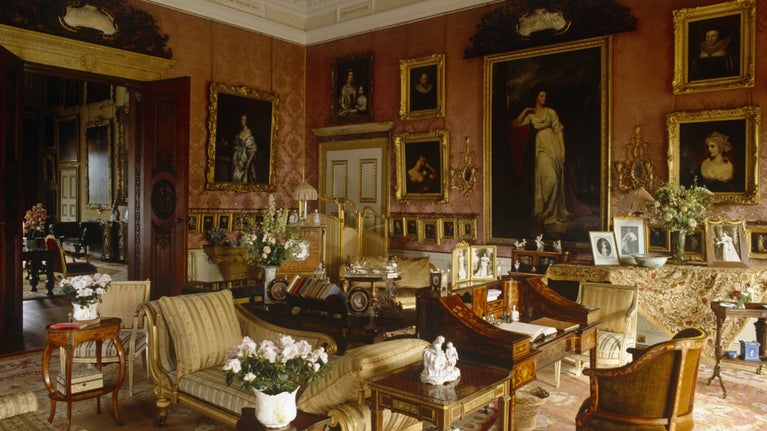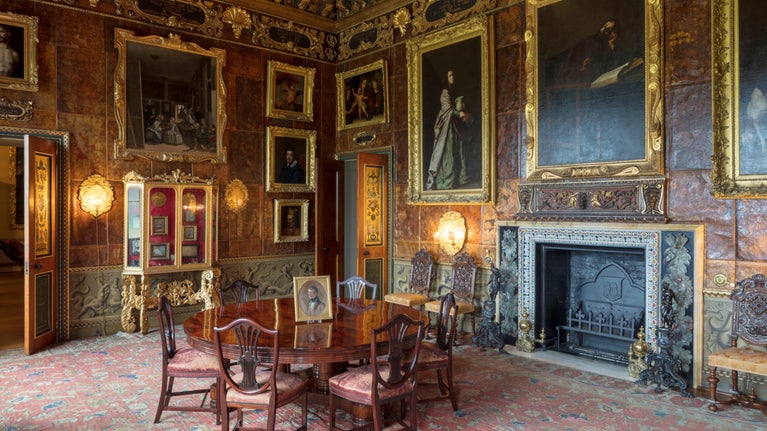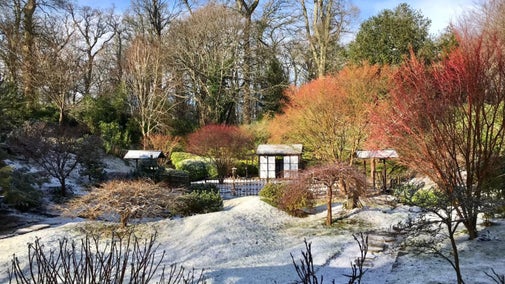
Discover more at Kingston Lacy
Find out when Kingston Lacy is open, how to get here, the things to see and do and more.

Kingston Lacy, Dorset, was home to the Bankes family for more than 300 years from the 17th century. The house today is largely the 19th-century creation of William John Bankes, who embellished the interiors and added to a significant art collection including paintings by Sir Peter Lely, Titian, and Rubens. The house is set at the heart of an 8,500-acre parkland and estate, which is grazed by the Bankes family’s beloved Red Ruby Devon cattle and includes the Iron Age hill fort Badbury Rings.
The name Kingston Lacy comes from the de Lacy family, which owned the estate when it formed part of the royal manor of nearby Wimborne. Archaeological remains of the medieval manor house are sited just north of the current mansion. The manor attracted visits from the English kings Henry III, IV and V, but was in ruins by the late 15th century.
Sir John Bankes (1589–1664) bought the land at Kingston Lacy in 1636, along with Corfe Castle where he made his family home. A successful legal and political career led to his knighthood and appointment as Attorney General to King Charles I.
The Bankes family sided with the King during the English Civil Wars (1642–52). Oliver Cromwell's Parliamentarian forces demolished Corfe Castle in 1646, after a long siege. According to family legend Mary, Lady Bankes (1598–1661), John’s wife, defended the castle during the siege. Research suggests that she was in fact in Oxford at the time. Nonetheless, the story earned her the nickname, ‘Brave Dame Mary.’
After the Restoration of the monarchy in 1660, John and Mary’s eldest son Sir Ralph Bankes (1631–1677) chose fashionable architect Sir Roger Pratt to build a new family home at Kingston Lacy. The compact and symmetrical red-brick mansion had its main entrance on the north side, as now, but a large flight of steps would have led into a grand entrance hall on the first floor.
Ralph, keen to emphasise his connection with the restored monarchy, employed Sir Peter Lely, court painter to King Charles II, to paint portraits of his family. These now hang in the library and form the finest collection of Lely portraits outside the British Royal Collection.

Henry Bankes the Younger (1757–1834) and his wife Frances (1760–1823) transformed the original entrance hall into a light and airy ballroom with full-length sash windows and a coved ceiling painted with fashionable ‘grotesque’ designs in pastel colours.
A full-length portrait, by George Romney, of Frances as a young woman is a celebration – and advertisement – of Frances’ beauty, and was painted shortly before her marriage in 1784. It is very likely that the renovations at Kingston Lacy were funded by Frances’ considerable dowry of £6,000 (about £700,000 today).
The money was paid by her father William Woodley, who owned sugar plantations on St Kitts and was Governor of both the Leeward Islands and Antigua. In 1836 following the abolition of slavery, their son acted as trustee for the Woodley family in making an unsuccessful compensation claim for 172 enslaved people.
Frances and Henry’s son, William John Bankes (1786–1855) was an intellectual, explorer and enthusiastic art collector. He travelled throughout Europe, the Middle East and Egypt, studying and acquiring art and artefacts. He bought works by Venetian painters, Titian, Tintoretto, and Sebastiano del Piombo, and two large portraits by Flemish artist Rubens. These joined his collection of 17th-century Spanish paintings: highlights include the scaled-down copy of Las Meninas that he bought as a Velasquez, but which is by the painter’s son-in-law, Juan Battista del Mazo; and Velazquez’s portrait of the Roman cleric, Camillo Massismi.
William John had a keen interest in the culture of ancient Egypt and was a pioneer of archaeological excavation in the country. He made highly accurate drawings of temple sites and hieroglyphic inscriptions. William John’s own translations greatly informed a full understanding of hieroglyphs in the early 19th century.
Kingston Lacy houses William John’s extensive collection of Egyptian artefacts, one of the largest in private possession. The Philae obelisk, which he removed, with permission from the Ottoman ruler, Mohammed Ali, from the island of Philae in the Nile during his explorations there in 1815 and 1818, was installed in the centre of the formal South Lawn in 1836.
William John radically remodelled and refurbished the house in the 1830s and 40s. He hired architect Charles Barry, who had designed the Palace of Westminster, to encase the exterior in local Chilmark stone and remodel the interiors around a grand Carrara marble staircase.
William John’s life changed dramatically when, in 1841, he fled England to escape prosecution for a same-sex act, then a capital offence. He spent the rest of his life in exile, mainly in Venice, and there commissioned a variety of artists and craftsmen to create decorative elements for his house back home.
The craftsmen were often working to William John’s own designs: limestone carvings by Veronese artist Salesio Pegrassi, a cabinet inlaid with semi-precious hard stones by the Florentine Buoninsegni brothers, and intricately carved doors and shutters. The pinnacle of his artistic flair are the 12 painted door panels he designed for his ‘Golden Room’ (the Spanish Room), depicting the months of the year.
His redesign of Kingston Lacy demonstrated his pride in the family’s 17th-century Royalist roots and his love for his Dorset home. The materials and furnishings that he chose, such as gilded leather wall coverings and carved walnut wood, reflect 17th-century fashions. He commissioned Baron Carlo Marochetti to create life-size bronze sculptures of Sir John and Lady Mary, and King Charles I to greet visitors as they ascend towards the lavish state floor.

William John’s great-nephew Walter Ralph Bankes (1853–1904) and his wife Henrietta (1867–1953) modernised the house, installing electricity and establishing a productive kitchen garden. Henrietta ran the estate from 1904 until her son, Henry John Ralph (1902–1981), came of age. She created a family home for her three children, while her determination to maintain the social status of the family led to visits from King Edward VII, Kaiser Wilhelm II and the Princess of Wales, the future Queen Mary.
During the Second World War, Kingston Lacy park was turned into a military hospital for D-Day casualties. The American 106th General Hospital operated there from 1944 to 1945. The complex had 100 buildings and treated more than 20,000 patients.
When the National Trust took over Kingston Lacy in 1981, extensive conservation work was needed including structural reinforcements, dry rot treatment and paintings conservation. The Japanese garden was reimagined in 2005, and the Kitchen Garden is currently undergoing conservation work to recreate its former glory.
Laing, Alastair, Kingston Lacy: Illustrated List of Pictures, National Trust, 2011.
Sebba, Anne, The Exiled Collector: William Bankes and the Making of an English Country House, 2004, Dovecote Press, 2009.
Usick, Patricia, Adventures in Egypt and Nubia: The Travels of William John Bankes (1766- 1855), British Museum, 2002.
Watkin, Pamela, A Kingston Lacy Childhood: Reminiscences of Viola Bankes, Dovecote Press, 1986.

Find out when Kingston Lacy is open, how to get here, the things to see and do and more.
Find out more about the Bankes family home. Discover art treasures and look at how a large home was used by the family and their visitors who came to stay.

Learn about some of the prized items that are housed at Kingston Lacy, several of which feature in the National Trust's book 125 Treasures.

Relax and wander the gardens to enjoy seasonal interest at any time of year, with plenty of space for children to run, skip and play, and spaces to stop along the way.

Groups of visitors are warmly welcomed by the National Trust at Kingston Lacy. Find out more about booking your tickets and the benefits you’ll get.

Conservation work both indoors and out is a vital part of what the National Trust does at Kingston Lacy. Discover more about our latest initiatives.

There are numerous ways that you can volunteer with the National Trust at Kingston Lacy. Find out how to join our team.

Learn about people from the past, discover remarkable works of art and brush up on your knowledge of architecture and gardens.

Explore the objects and works of art we care for at Kingston Lacy on the National Trust Collections website.
